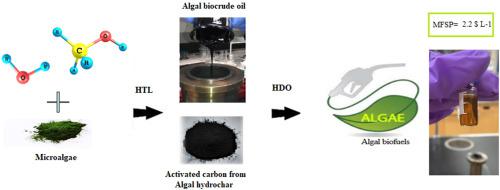Biomass & Bioenergy ( IF 5.8 ) Pub Date : 2021-06-29 , DOI: 10.1016/j.biombioe.2021.106168 Shima Masoumi , Ajay K. Dalai

|
The hydrochar, a by-product of hydrothermal liquefaction (HTL) of algal biomass, was utilized through two methods; combustion and activation, for its usage as a source of heat and a catalyst support for hydrodeoxygenation (HDO) process in the production of algal biofuels. In this study, techno-economic analysis (TEA) and life cycle assessment (LCA) of algal biofuels production in a two-stage process (HTL and HDO) were investigated. Aspen plus simulation and SimaPro software were used to analyze process economics and greenhouse gas (GHG) emissions. Microalgae at 200 dry metric tonnes day−1 was the basis for its conversion to biocrude oil through HTL in the methanol-water system followed by catalytic upgrading to produce biofuels. According to HTL experimental results, maximum biocrude oil yield of 57.8 wt% was obtained using microalgae-solvent mass ratio and methanol-water mass ratio of 1:5 and 3:1, respectively. Produced biocrude oil contained 14.5 wt% of oxygen and HHV of 33.4 MJ kgbiocrude oil−1 which required upgrading to be utilized as a transportation fuel. HDO was employed to enhance the quality of biocrude oil with decrease in oxygen content (3.1 wt%) and increase in HHV (42 MJ kgbiofuel−1). The minimum fuel selling price (MFSP) for using method #2 (activation) was 2.2 $ L−1 to breakeven the cost of operation, which was about 10% lower than that from method #1 (combustion). The GHG emissions performance was estimated at −1.13 gCO2-eq MJ−1 indicating the significant GHG emissions reduction compared to petroleum-based fuels production.
中文翻译:

微藻在甲醇-水系统中水热液化和以水炭为催化剂载体的催化加氢处理生产生物燃料的技术经济和生命周期分析
Hydrochar 是藻类生物质水热液化 (HTL) 的副产品,通过两种方法加以利用;燃烧和活化,因为其在藻类生物燃料生产中用作加氢脱氧 (HDO) 过程的热源和催化剂载体。在这项研究中,研究了两阶段过程(HTL 和 HDO)中藻类生物燃料生产的技术经济分析 (TEA) 和生命周期评估 (LCA)。Aspen plus 模拟和 SimaPro 软件用于分析过程经济性和温室气体 (GHG) 排放。每天 200 干公吨的微藻-1是其通过甲醇-水系统中的 HTL 转化为生物原油的基础,然后进行催化升级以生产生物燃料。根据 HTL 实验结果,使用微藻-溶剂质量比和甲醇-水质量比分别为 1:5 和 3:1 时,生物原油的最大产量为 57.8 wt%。生产的生物原油含有 14.5 wt% 的氧和 33.4 MJ kg生物原油-1 的HHV ,需要升级以用作运输燃料。HDO 用于提高生物原油的质量,同时降低氧含量(3.1 wt%)和增加 HHV(42 MJ kg生物燃料-1)。使用方法#2(激活)的最低燃料销售价格(MFSP)为 2.2 $ L -1以实现运营成本收支平衡,这比方法#1(燃烧)的成本低约 10%。温室气体排放性能估计为 -1.13 gCO 2-eq MJ -1,表明与石油基燃料生产相比,温室气体排放量显着减少。







































 京公网安备 11010802027423号
京公网安备 11010802027423号